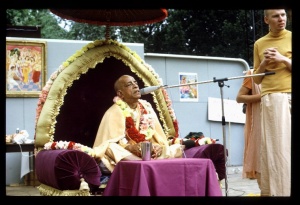CC Adi 10.90 (1975)

A.C. Bhaktivedanta Swami Prabhupada
Below is the 1996 edition text, ready to be substituted with the 1975 one using the compile form.
TEXT 90
- śāstra-dṛṣṭye kaila lupta-tīrthera uddhāra
- vṛndāvane kaila śrīmūrti-sevāra pracāra
SYNONYMS
śāstra-dṛṣṭye—according to the directions of revealed scriptures; kaila—did; lupta—forgotten; tīrthera—places of pilgrimage; uddhāra—excavation; vṛndāvane—in Vṛndāvana; kaila—did; śrī-mūrti—Deity; sevāra—of worship; pracāra—propagation.
TRANSLATION
In accordance with the directions of the revealed scriptures, both Gosvāmīs excavated the lost places of pilgrimage and inaugurated the worship of Deities in Vṛndāvana.
PURPORT
The spot where we now find Śrī Rādhā-kuṇḍa was an agricultural field during the time of Caitanya Mahāprabhu. A small reservoir of water was there, and Śrī Caitanya Mahāprabhu bathed in that water and pointed out that originally Rādhā-kuṇḍa existed in that location. Following His directions, Śrīla Rūpa Gosvāmī and Sanātana Gosvāmī renovated Rādhā-kuṇḍa. This is one of the brilliant examples of how the Gosvāmīs excavated lost places of pilgrimage. Similarly, it is through the endeavor of the Gosvāmīs that all the important temples in Vṛndāvana were established. Originally there were seven important Gauḍīya Vaiṣṇava temples established in Vṛndāvana, namely the Madana-mohana temple, Govinda temple, Gopīnātha temple, Śrī Rādhāramaṇa temple, Rādhā-Śyāmasundara temple, Rādhā-Dāmodara temple and Gokulānanda temple.